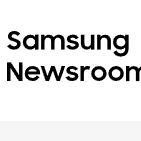-
Similar Topics
-
By Samsung Newsroom
Samsung Electronics, the Official Art TV of Art Basel, delivered an immersive experience at Art Basel Hong Kong, the premier global art fair, from March 28-30. Attendees who visited Samsung’s ArtCube lounge discovered a new appreciation for artworks displayed on Samsung’s premium 2025 Smart TV lineup, including The Frame, MICRO LED and Neo QLED 8K.
▲ Artist Marc Dennis is standing inside the Samsung ArtCube, surrounded by his artworks.
“Samsung continues to make digital art accessible to more people through our premium display lineup,” said Hun Lee, Executive Vice President of Samsung Electronics’ Visual Display Business. “As the leader in Art TVs and Official Visual Display partner of Art Basel, the world’s most prestigious art fair, we remain committed to bringing the Art Basel experience to a wider audience with the Samsung Art Store.”
▲ Visitors at the Samsung ArtCube enjoyed various artworks on MICRO LED.
This year, Art Basel Hong Kong highlighted 240 galleries from 42 countries, with more than half of the artworks coming from Asia and the Asia-Pacific, showcasing the region’s dynamic cultural landscape.
At the fair, Samsung hosted a dedicated ArtCube lounge under the concept, ‘Borderless: Dive into the Art,’ featuring specially curated art collections available in stunning 4K quality on the Samsung Art Store. Additionally, visitors were able to experience artworks by five contemporary artists, including Kunyong Lee, Aerosyn-lex Mestrovic, Saya Woolfalk, Marc Dennis and Jules de Balincount.
▲ Artist Jules de Balincourt is standing inside the Samsung ArtCube, surrounded by his artworks displayed on Samsung Art TVs.
The ArtCube lounge featured five premium Samsung TVs, including The Frame, MICRO LED and Neo QLED 8K, delivering a breathtaking digital art experience. Upon stepping into the ArtCube lounge, visitors were welcomed by a display of artworks unfolding across the screens, creating an endlessly expanding and immersive artistic environment that unlocked a new appreciation of digital art.
▲ (From left) Hayley Romer, CGO at Art Basel converses with Daria Greene, Head of Content and Curation at Samsung.
In addition to its dynamic lounge experience, Daria Greene, Head of Content and Curation at Samsung, hosted a series of panel discussions featuring influential voices from the contemporary art world. These sessions included:
Bridging Worlds: How Technology is Transforming Art Appreciation & Accessibility
This conversation with Hayley Romer, Chief Growth Officer at Art Basel, delved into how digital innovation redefined the way art was created, displayed and appreciated—making it more immersive and accessible to global audiences than ever before. Romer mentioned, “In partnership with Samsung, we are updating our artworks in the Samsung Art Store every quarter. It is a lot of fun to find and explore the lovely pieces chosen by Art Basel, as well as those from museums.” Blending Old & New: A Fireside Chat with Marc Dennis
Renowned hyper-realistic painter Marc Dennis joined the discussion about his artistic practice of skillfully blending Old Master techniques with modern themes to craft art that was both timeless and provocative. “Unlike in traditional museums, Samsung Art TVs allow people to spend as much time as they want with artworks, which is important to me because my works are very detailed,” Dennis explained.
▲ Hyper-realistic artist Marc Dennis describes how the Samsung Neo QLED 8K showcases this artwork with meticulous distinction.
Samsung recently launched a new Art Store collection featuring 23 curated artworks from Art Basel Hong Kong’s renowned galleries, made available on March 17, 2025. Global subscribers to the Art Store can now enjoy more than 3,000 pieces from world-leading museums and galleries, available on Samsung TVs including The Frame, MICRO LED, Neo QLED and QLED TVs.
▲ Samsung ArtCube displayed artworks created by artist Aerosyn-lex Mestrovic.
For more information, visit www.samsung.com.
View the full article
-
By Samsung Newsroom
Samsung Electronics, the world’s leading TV manufacturer for 19 consecutive years, is kicking off the 2025 Tech Seminars in Frankfurt, Germany, from March 18–19, giving media and industry professionals an exclusive first look at its most advanced AI-powered TV and audio innovations before they hit the market.
Now in its 14th year, the seminar provides field experts with hands-on experiences of Samsung’s latest TV lineup ahead of its official release. This year, the seminar will be showcasing technologies related to AI-powered picture quality, immersive sound, and next-generation viewing experiences.
Revolutionizing the Screen Experience With AI
Samsung’s 2025 TVs will feature powerful AI-driven features designed to enhance the user experience. At the heart of this innovation is Vision AI, an advanced platform that personalizes and simplifies the way users interact with their screens. Features such as Click to Search allows viewers to instantly access relevant information about on-screen content, while Live Translate provides real-time audio translations for seamless global viewing. Quick Remote transforms a smartphone into a control hub, offering a more intuitive and connected experience.
Samsung has also introduced a seamless multi-device experience, enabling effortless content sharing and control across Samsung devices. Features like Storage Share, which allows easy file transfers between Galaxy devices and TVs, and Multi Control, which lets users operate multiple Samsung devices with a single keyboard and mouse, create a more connected and streamlined ecosystem.
Next-Generation OLED & Neo QLED Picture Quality
Samsung’s 2025 OLED TVs introduce Glare Free 2.0, minimizing reflections for a crystal-clear and immersive experience. Powered by the NQ4 AI Gen3 Processor and 128 neural networks, AI Upscaling sharpens details with remarkable precision, while OLED HDR technology boosts brightness and contrast.
The 2025 Neo QLED 4K lineup features advanced local dimming for deeper blacks and enhanced HDR accuracy. AI Motion Enhancer, previously exclusive to 8K models, is now available in 4K TVs, delivering ultra-smooth visuals ideal for sports and action-packed content.
Expanding the Lifestyle TV Portfolio
Samsung’s Lifestyle TV lineup continues to push boundaries of design and innovation, blending cutting-edge technology with personalized home aesthetics.
The Frame Pro redefines both entertainment and home décor, now featuring Mini-LED Local Dimming for enhanced brightness and lifelike picture quality. With access to over 3,000 digital artworks via Samsung Art Store, users can instantly transform their TV into a stunning personal gallery. The addition of Wi-Fi 7 ensures seamless installation, reducing cable clutter for a cleaner, more sophisticated setup.
Meanwhile, The Premiere 5 offers a compact yet powerful projection experience with touch interaction, making it ideal for gaming, education, and immersive home entertainment. Designed for versatility, it delivers immersive visuals in a range of environments, from classrooms to home theaters and much more.
Introducing the Next Era of Immersive Sound
Samsung is redefining audio innovation with Eclipsa Audio, the industry’s first IAMF 3D sound technology developed in collaboration with Google. This advanced system optimizes spatial sound by analyzing environmental reflections, delivering a deeply immersive surround sound experience.
At the 2025 Tech Seminar, attendees will be among the first to experience Eclipsa Audio firsthand and see its seamless integration with Samsung’s latest soundbars for a next-level home theater experience.
“At Samsung, we’re committed to making all the devices you use smarter and more connected,” said Benjamin Braun, Samsung Europe’s Chief Marketing Officer. “Whether it’s using Vision AI to automatically optimize your TV settings or AI-powered services to make activities such as search or home management simpler, we’re showing how technology can feel more personal and tangible than ever before.”
Following the Frankfurt event, Samsung will bring the Tech Seminar series to key regions including Southeast Asia and Latin America, providing more industry professionals with exclusive hands-on previews of its AI-powered display and audio innovations ahead of their market launch.
▲ Kevin Cha from Samsung’s Picture Quality Solution Lab explains how Glare Free 2.0 technology and OLED HDR technology enhance viewing comfort.
▲ Haylie Jung from Samsung’s Picture Quality Solution Lab highlights advanced local dimming and AI-powered enhancements in the 2025 Neo QLED 4K, featuring the NQ4 AI Gen3 Processor.
▲ Steffen Greb from Samsung’s ECSO demonstrates Vision AI and seamless multi-device connectivity across Samsung products.
▲ Deokhwan Kim from Samsung’s Picture Quality Solution Lab demonstrates The Premiere 5’s touch capabilities.
▲ Hyungwoo Kim from Samsung’s Sound Device Lab showcases Eclipsa Audio, Samsung’s 3D audio technology, allowing users to enjoy immersive three-dimensional sound experience.
View the full article
-
By Samsung Newsroom
Samsung Electronics today announced that approximately 80 models in its 2025 TV, monitor and soundbar lineups have received Product Carbon Reduction1 and Product Carbon Footprint2 certifications from TÜV Rheinland, a globally recognized certification organization based in Germany. This marks the fifth consecutive year that the premium lineups, Neo QLED 8K and Neo QLED, have received certifications, reinforcing the company’s continued efforts in carbon reduction.
“Samsung Electronics is committed to driving technological innovation for a sustainable future,” said Taeyong Son, Executive Vice President of Visual Display Business at Samsung Electronics. “As the world’s leading TV manufacturer, we will continue to be at the forefront of establishing a more energy-efficient ecosystem that benefits consumers.”
Following last year’s certification of 60 models across the Neo QLED, OLED and Lifestyle TV categories, Samsung has further increased its number of certified products in 2025 to include QLED TVs. In addition, the company is also working towards obtaining certification for its Color E-Paper lineup later this year.
The certifications from TÜV Rheinland are awarded following a rigorous evaluation of a product’s entire lifecycle — including manufacturing, transportation, usage and disposal — based on internationally recognized sustainability standards. By assessing and verifying carbon emissions at each stage, these certifications highlight Samsung’s efforts to reduce environmental impact across its product lineup.
In particular, the Product Carbon Reduction certification is granted to products that have already received a Product Carbon Footprint certification and further demonstrate a measurable reduction in carbon emissions compared to their predecessors.
Samsung’s leadership in energy-efficient display technology dates back to 2021, when the Neo QLED became the first 4K and higher-resolution TV to earn the Reducing CO2 certification. Since then, Samsung has continually expanded its portfolio of environmentally certified products, including QLED, Crystal UHD, Lifestyle TVs, OLED TVs and a wide range of monitors and digital signage products.
For more information on Samsung’s 2025 TV lineup, please visit www.samsung.com.
1 38 Certified models include Neo QLED 8K(QN990F, QN950F), Neo QLED 4K(QN90F, QN85F), OLED(S95F 55”/65”, S90F, S85F 77”/83”), The Frame Pro(LS03FW), LCD Signage(QMC 43”, 50”, 55”, 75”), and Soundbar(Q930F, Q800F, QS700F) products.
1 42 Certified models include Neo QLED 8K(QN900F), Neo QLED 4K(QN80F, QN70F), OLED(S95F 77”/83”, S85F 55”/65”), The Frame(LS03F), QLED(Q8F, Q7F), Viewfinity S80UD, S80D, QMC 65’’/85’’, Soundbar(Q990F), EMDX 32″.
View the full article
-
By Samsung Newsroom
Samsung Electronics today announced that it has secured its position as the global leader in the TV market for the 19th consecutive year.
According to market research firm Omdia, Samsung achieved a 28.3% market share in the global TV market in 2024, maintaining the number one ranking it has held since 2006. This continued success is driven by the company’s commitment to premium and ultra-large screen innovation, as well as the introduction of cutting-edge, AI-powered TVs.
“Samsung’s 19-year reign as the global TV market leader has been made possible by the trust and support of our customers,” said Hun Lee, Executive Vice President of Visual Display Business at Samsung Electronics. “We will continue to shape the future of the TV industry with innovations like AI-powered TVs, delivering products and services that meaningfully enrich people’s lives.”
▲ Samsung Electronics secured its position as the global leader in the TV market for the 19th consecutive year (Source: Omdia , Feb-2024. Results are not an endorsement of Samsung)
Dominance in the Premium and Ultra-Large TV Segments
Samsung solidified its leadership in the high-end TV market, particularly in the premium ($2,500+) and ultra-large (75-inch and above) segments:
Premium ($2,500+) TVs – Samsung captured a 49.6% market share, accounting for nearly half of the global premium TV market. 75-inch and above – Samsung led the ultra-large category with a 28.7% market share.
QLED and OLED TV Success
Samsung also maintained its leadership in the QLED and OLED segments, reinforcing its dominance in the premium TV industry:
QLED TVs – With 8.34 million units sold, Samsung commanded a 46.8% market share, further strengthening its leadership in this category. The global QLED market also saw significant growth, surpassing 10% of total TV sales for the first time. OLED TVs – Samsung’s OLED sales reached 1.44 million units in 2024, securing a 27.3% market share. This marks a year-over-year (YoY) increase of 42% and 4.6% in unit sales and market share, respectively, reflecting strong consumer demand for Samsung’s OLED innovations.
Transforming Home Entertainment With AI and Art
At CES 2025, Samsung unveiled Vision AI, a breakthrough in AI-powered screens that extends beyond traditional entertainment. By analyzing user preferences, intent and habits, Vision AI delivers a seamlessly personalized viewing experience that shapes the future of smart home displays.
Samsung is also expanding its Samsung Art Store — originally available exclusively on The Frame — to Neo QLED and QLED models this year, providing more consumers with access to a personalized digital art experience.
View the full article
-
By Samsung Newsroom
Samsung Electronics today introduced its latest advancements in home audio technology with the new Q-series (HW-Q990F and HW-QS700F) soundbars These flagship models combine state-of-the-art hardware with intelligent AI-driven features, designed to elevate home entertainment with unparalleled sound
“Our new soundbars combine exceptional audio quality with seamless convenience,” said Hun Lee, Executive Vice President of the Visual Display Business at Samsung Electronics. “With advanced AI technology in the HW-Q990F and the HW-QS700F’s innovative convertible design, these soundbars effortlessly adapt to any environment, delivering an immersive and personalized audio experience for every user.”
HW-Q990F: Redefining Flagship Audio Performance
As the successor to the highly acclaimed HW-Q990D, the HW-Q990F takes home audio to new heights. It features newly engineered dual active subwoofers that deliver robust bass and ultra-low-frequency precision. Plus, a new cube design reduces the subwoofers to half the size of its predecessor, minimizing resonance and blending flawlessly into modern interiors with a refined serrated finish.
The HW-Q990F also delivers advanced AI-driven sound optimization through features such as:
Dynamic Bass Control: Enhances clarity in low-frequency ranges by utilizing non-linear bass management for balanced and distortion-free sound. Q-Symphony: Immerses the user in 3D surround sound by detecting the position of wireless speakers like the Music Frame and automatically optimizing audio effects based on its distance and angle. Active Voice Amplifier Pro: Provides real-time content analysis that reduces background noise and emphasizes dialogue for an enhanced viewing experience.
Additionally, the HW-Q990F utilizes the Samsung TV’s Neural Processing Unit (NPU) in Q-Symphony mode, making dialogue clearer and delivering more immersive, synchronized audio.
HW-QS700F: Versatility Meets Elegance and Superior Sound
The HW-QS700F offers even more versatility in home audio with its sleek design and innovative gyro-sensor technology. Suitable for both wall-mounted and tabletop setups, this soundbar adapts to the user’s space. Its built-in gyro-sensor can automatically detect whether it’s positioned vertically or horizontally, fine-tuning the audio output to ensure optimal clarity and immersive sound in any configuration.
With its slim, modern profile, the HW-QS700F integrates into any room. Its adaptive design offers flexibility without compromising style, making it the perfect companion for a cinematic wall-mounted display or a minimalist tabletop setup. This soundbar delivers an audio experience as sophisticated as its design — ideal for users who demand both elegance and performance.
For more information, visit Samsung.com.
View the full article
-
-
-
Similar Tagged Content
-
- 0 replies
- 1,845 views
-
- 0 replies
- 2,521 views
-
- 1 reply
- 3,824 views
-
- 7 replies
- 22,030 views
-
- 0 replies
- 2,057 views
-




Recommended Posts
Join the conversation
You can post now and register later. If you have an account, sign in now to post with your account.
Note: Your post will require moderator approval before it will be visible.